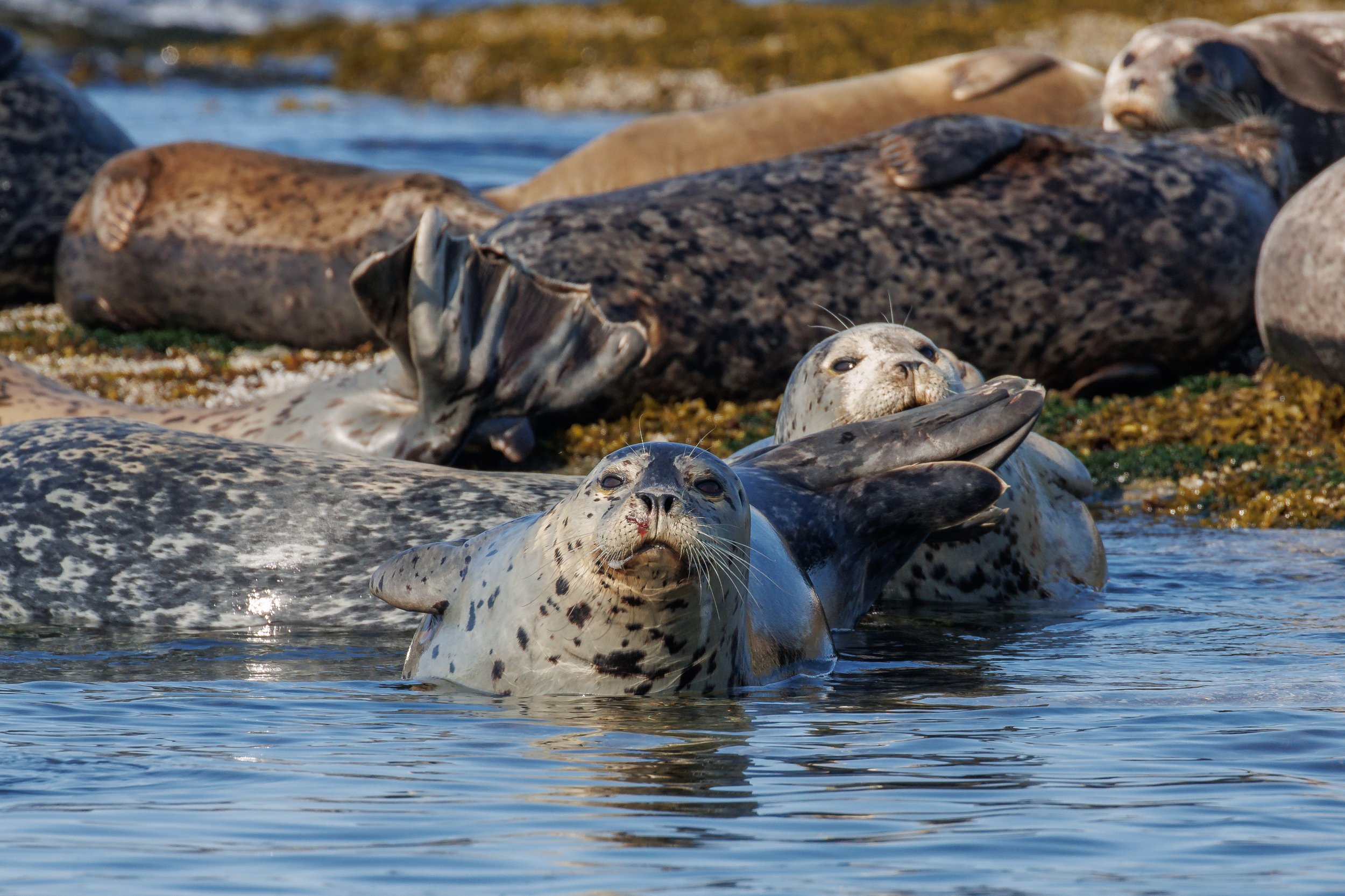June 28, 2023, 3:30 PM - The T099s and some Brown Pelicans!
The afternoon of June 28th took us back to the same pod of whales travelling as we saw this morning but in a different location this time! We had left this group earlier heading northwest along the Strait of Georgia, but now we found them heading South-east, the opposite way that they were going this morning. That’s the great thing about our wildlife, they can be very unpredictable in their freedom. We wouldn’t want it any other way!
This afternoon we saw the T099s, a pod of Transient orca which consists of a matriarch leading around her 4 kids. The members of the pod are as follows:
T099 Bella ♀ (~1984)
T099B Holly ♀ (2007)
T099C Barakat ♂ (2009)
T099D Puck ♂ (2015)
T099E ♀ (2021)
While we were watching these 5 spread out along the sandy banks at the mouth of the Frasier River, there was a rare sight overhead: a pair of Brown Pelicans!
Pelicans are very distinct-looking birds. When they are hunting they will dive into the water and capture fish in their large throat pouches. These pouches will drain the water out as the pelican comes to the surface and then the pelican will quickly gobble up the fish they just caught. Seeing them in British Columbia is not very common, as their range tends to be further south, in warmer, more clear waters.
Here in BC you don’t see a lot of birds who dive from flying into the water since our waters tend to have poor visibility, meaning that they just can’t see through to aim their dive and catch fish as successfully. This is due to the high productivity of our waters. Each tablespoon of seawater off BC’s coast is estimated to have around 1 million microorganisms living in it. That high concentration is what allows us to have a such high biodiversity and for there to be so many amazing animals like our whales here, but it makes them have to have different adaptations and feeding mechanisms than in other areas in the world. Most of our fishing birds will swim through the water after scouting along the surface instead of doing the more intense aerial dives that you might see on the Atlantic Coast of Canada.
Where we were today the visibility is even worse since the sediment being carried by the Fraiser River would be decreasing the visibility in the water even more. This sediment does increase nutrients in the water though which draws in high concentrations of fish, seals, sea lions, and all the predators chasing them in, like the Pelicans and Transient Orca that we saw here today.
The orca were spread out, trying to find something to eat along their path today, but had no luck while we were watching them. Instead, we got to see them travelling south with the beautiful backdrop of Vancouver.
After our hour with the whale was up, it was time to be off and find some other wildlife to look at! Our vessels headed across the Strait towards Porlier Pass where to turned and headed up the Valdes shoreline until we got to one of our favourite places: Sticky Rock! This rocky islet is usually teeming with life, with Haul outs of both Steller Sea Lions and Harbour seals being present today. We also had some cormorants hanging out here today.
After leaving stinky, we headed through Gabriola Pass, inside the Southern Gulf islands, to Ruxton Pass, North to Dodd Narrows, and then back to the Nanaimo Harbour. It was an amazing day spent with the T099s!
All the photos from the day where taken by our onboard Naturalists Cheyenne Brewster and Val Watson.
Our Semi-Covered vessel, Kula. Photo by Val Watson.
One of our Open Zodiacs, Cascadia. Photo by Cheyenne Brewster.
A pair of brown pelicans! Photo by Val Watson.
Looking for lunch. Photo by Val Watson.
T099C Barakat. Photo by Val Watson.
T099C Barakat and his big sister T099B Holly. Photo by Val Watson.
T099B Holly. Photo by Val Watson.
T099C Barakat. Photo by Val Watson.
T099B Holly with her chin above water! Photo by Val Watson.
T099 Bella. Photo by Val Watson.
T099D Puck and his older brother T099C Barakat. Photo by Val Watson.
T099C Barakat. Photo by Val Watson.
T099C Barakat. Photo by Val Watson.
T099C Barakat. Photo by Val Watson.
Photo by Val Watson.
A herd of sea lions. Photo by Val Watson.
Scratching - can you spot this sea lion’s claw? Photo by Val Watson.
The ultimate cuddle puddle! Photo by Val Watson.
Photo by Val Watson.
A Double-crested cormorant amongst some Harbour seals. Photo by Val Watson.
You never realize just how big cormorants are until you see one beside a seal. Photo by Val Watson.
A Harbour seal with either new wounds or left overs from dinner. Photo by Val Watson.
A gull on the rocks. Photo by Val Watson.
What a funky pose to sleep in! Photo by Val Watson.
Another Harbour seal with a booboo. Photo by Val Watson.
Our Open Zodiac, Cascadia. Photo by Cheyenne Brewster.


























